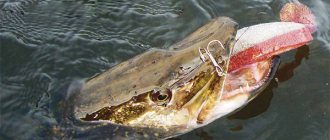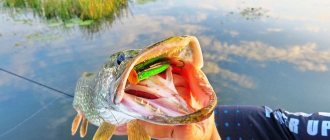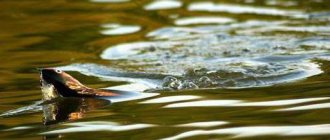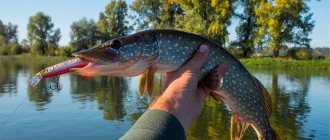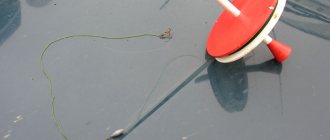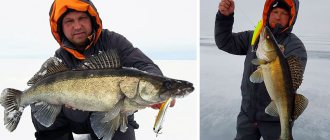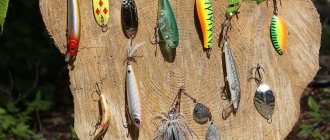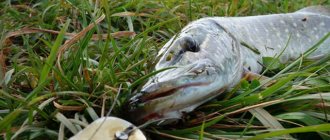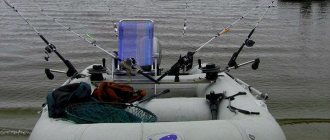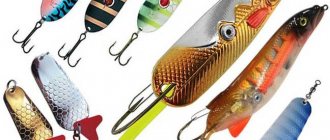Rattlin is a type of bladeless wobbler that works as a scout on an unfamiliar body of water.
A distinctive feature of this species is the rattle in the body of most models, which attracts pike from a long distance with its noise.
For successful fishing you need to have a set of knowledge on the selection of baits and fishing methods.
What is rattlin?
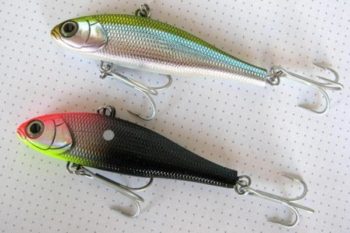
The release of the rattlin and popper, models without blades, brought additional color to this type of fishing. Essentially, this is a small wobbler. The body of the bait is made flatter, the front blade is missing. But inside the body there is a special chamber with balls, which create noise when the bait moves.
Important! The game of bait is attractive to pike. A high frequency of oscillations with a small amplitude of movements is the distinctive ability of rattlins. A model was developed for perch fishing, but practice has shown high catchability of pike perch and pike perch.

Features, characteristics and comparison of rattlins with wobblers
There are several main differences between rattlins and wobblers and the characteristics of the bait:
- One of the main distinguishing features is the body shape of a bladeless wobbler. Some manufacturers produce models with a wide head. This is a type of lobe bait. Catchable under various fishing conditions. Slow retrieval is able to reveal all the characteristics of a high-frequency, small-amplitude game of bait. The more rounded front end further reduces the amount of lateral deflection. This feature is revealed only with a certain method of management.
- They differ from wobblers and from each other in the presence of a separate chamber with rattles built into the body. This is important when winter fishing for pike. The pike escapes from the noise at this time, so models with a rattling head are used in open water. They are especially catchy in reservoirs with muddy water, attracting the attention of the lateral line of predators at long distances.
- This type of bait catches pike in mid-water, but heavier rattlins are produced that work at greater depths. For sea fishing, Asian manufacturers have developed models that are one and a half times heavier than their analogues. These rattlins can be used for catching pike on large lakes or in strong currents. Classic rattlins activate a well-fed, passive pike.
The bait can become vertical when reeling, this is due to the upper location of the fastening loop. But the main difference from wobblers is the absence of a nose blade and the excellent action of this bait, which works in open water and when fishing for predators under the ice.
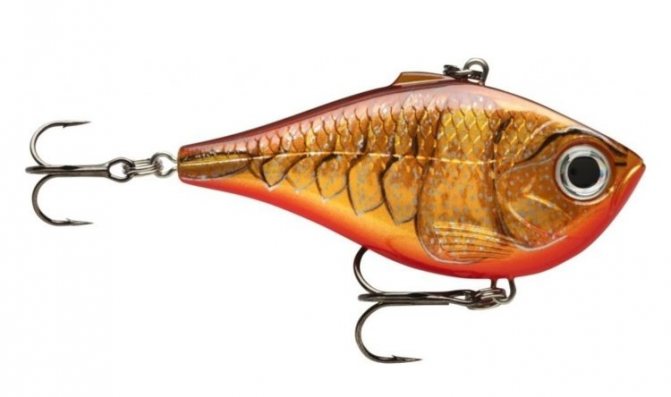
Rattlin's choice
When selecting baits, you should pay attention to 4 basic rules:
- For pike fishing, it is important to choose the right bait size. Rattlin with a body length of 65–90 mm will help you avoid empty bites.
- Fishing from ice - at this time, the elongated body of rattlins is more effective. Winter models should have natural colors; it is better to buy a silver bait. 80–100 mm is the length of baits for winter.
- Rattlins with cuts on the side surfaces attract more pike. This bait activates the fish with a very slow retrieve, which is important when fishing for pike in late autumn, during the feeding season.
- To create small turbulences when the rattlin moves, the tail tee is equipped with various decorations . Many anglers advise removing the rear hook, thus reducing the number of snags.
Important to remember! When going on winter fishing, you should prepare silent large rattlins. But in open water, the predator prefers to attack the bait with a rattle.
Features of ratlins
Pike react to rattlins no worse than to classic wobblers, and sometimes even better, since along with animation they have a sound effect. The bait has several names: you can find two spellings of the word “ratlin” and in addition to this the definition of Vibration (vib). During the retrieve, the bait transmits a certain vibration frequency to the side line of the predator, which is especially helpful for catching pike in troubled water.
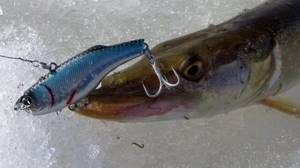
Ratlins are often called universal baits. Many agree that they are not so simple: you need to get used to them, otherwise disappointment is inevitable. From the classic wobbler, the Ratlin only has a plastic body that imitates a fish and tees. By the way, a treble hook is often replaced with a double hook in order to somehow reduce the high grip of the bait.
The versatility of ratlins lies in the fact that they can catch almost any predator, and also in the fact that they make it possible to fish all horizons - from the bottom to the surface, despite the fact that most of them are sinking bait.
By adjusting the speed of the retrieve, it can be carried out both at the bottom and in the upper layers of water, which means that pike fishing becomes more effective without changing bait.
Ratlins are better suited for fishing in deep areas than other representatives of the wobbler class, which allows you to achieve good results even when the season for silicone has not yet begun.
Pike are caught on ratlins all year round. This bait performed well both in summer and winter. The Ratlin does not have a blade for deepening; its design has a lot of differences from the classic wobbler. Resistance in water is provided by a wide frontal part with a recess. The mount is not located in the bow, but moved to the back, that is, in the likeness of a balancer, thanks to which fishing is carried out vertically with ratlins in winter.
The best rattlins
The rating shows the leaders for winter and spinning fishing. Each fisherman has his own opinion, but, according to the reviews of the majority of river predator hunters, we have compiled the 10 best.
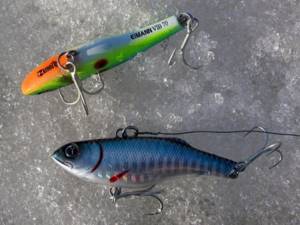
TOP 10 best rattlins for pike fishing
These include the following models:
- Rattlins produced by the company occupy a leading position. Bay Ruf SV are available in sizes 70 mm, 80 mm. A very catchy model for pike, but to catch trophy specimens you will need to replace the tees. In this case, the game of the bait may be disrupted.
- Fishermen call the Zip Baits Rigge Vib “redhead”; it is one of the most catchy winter models. Dimensions: 58 mm and 63 mm. Has an attractive play with silent vertical wiring.
- Mira VIB 83 bait allows you to perform long-distance accurate casting. Attracts fish with the work of the ratchet and the play of the bait's body with any type of spinner fishing. Uniform and slow, capable of attracting autumn fattening pike. The holographic coloring of the bait is complemented by the installation of fish eyes.
- The high-frequency action of the Hardcor FINTAIL VIBE 70 perfectly attracts pike at great depths. There is a small tail on the body of the bait, which adds additional color to the game. Lure weight 18 g.
- Rattlin "Rapala" is a famous Japanese deep-sea bait that can work at a certain level. The colors are made in different tones, so every fisherman can choose the best bait in his opinion. Body size - 70 mm, weight 16 g. A high-quality bait is made of excellent plastic that is not subject to breakage from pike jaws.
- Halco Max is a sea rattlin, but also works well in fresh water when catching predators. The main distinguishing feature of the bait is its narrow, elongated body weighing 80 g. Well suited for trolling fishing. Shows good results at a depth of 2–3 m.
- Winter rattlins Maria Slice . Slightly curved body with a narrow frontal part and a slight widening at the rear. This silent bait is catchy in open water. Casting range is provided by: bait weight (15 g) and body size (70 mm). Works at depth with vertical trolling and when fishing from a boat in reservoirs with standing water and in the current.
- Inexpensive model Strike Pro Flap Jack . It has 2 rings for fastening, which allows you to change the angle of inclination of the bait when retrieving. Mounting the rattlin closer to the front allows for smoother movements. It is made of high-quality plastic with different shades of color. For pike, bait lengths of 75 mm and 90 mm are used.
- Rattlins are manufactured in noise and silent versions. These baits are catchy all year round, but the best results are during the predator’s feeding season. The weight of the bait is 14.5 g, length 61 mm.
- Twitching Lure is an innovative lure that is suitable for any predatory fish. It works by imitating the behavior of a wounded fish. Increases catch by at least 3 times in any fishing conditions.
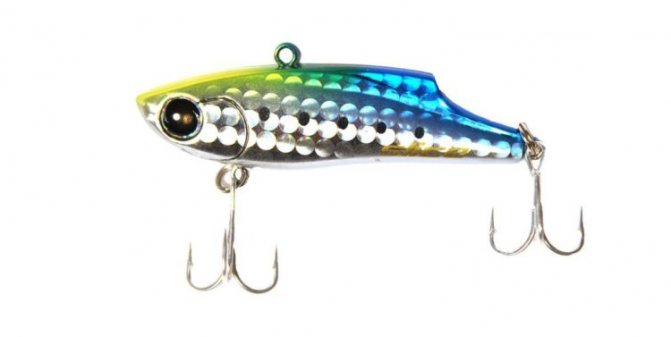
Choosing a color
The general rule applies here for all lures for pike fishing.
Important! Fishing at a depth of up to 5 m at normal lighting levels - in these conditions it is better to use baits of natural colors with the addition of some decorative finishes in the form of fish eyes, pearlescent spots on the body of the bait. For fishing at greater depths, poisonous colors are used with some additional decorations in the color of the bait and hook.
But in any case, it is important to prepare several proven bait options for fishing.

Noise or non-noise
Here the answer is clear. Winter does not tolerate noise. At this time, the pike is more careful and may be frightened by the additional noise effect. Therefore, ratchets are used in open water when fishing with spinning rods. But the tastes of fish can change dramatically, and for summer fishing you can take silent rattlins, which perfectly lure pike without making noise.
This applies only to pike; perch is attracted in winter not only by the game of the rattlin, but also by the noise effect from the bait.

Rattlins for pike: Top 10
This rating shows universal, well-proven rattlins that are suitable even for a beginner. The baits are working, time-tested. ??so, top rattlins for pike:
Daiwa TD Salt Vibration
It has an elongated body that naturally moves in the water. The bait is heavy and sinks quickly. Three color options are available. In winter it is better to use a silver rattlin, but in summer the color does not play a significant role; all three types are suitable. Length – 90 mm, product weighs 28 g.
Megabite (Liberty) Gamauji Jr
??used for hunting medium and large pikes. Heavy, capable of confidently walking along deep edges (5–7 m). Length – 85 mm, weight – 36 g.
Lucky Craft Varid 90
Ideal for uniform, jerky and step-by-step wiring. Working depth – from 50 cm to 1 m. Elongated rattle with balanced load. Length – 90 mm, weight – 21 g. Lucky Craft Varid 90 has excellent flight properties.
Yo-Zuri Hardcore Drum
Allows you to catch cautious pike at a depth of 1–2 meters. It sinks slowly and makes loud noises while retrieving. Length – 70 mm, weight – 18 g.
Rapala Clackin Rap
Thanks to its universal abilities and high catchability, this rattlin is one of the best. It consistently allows you to catch pike from 0.5 to 5 kg in spring, summer and autumn. Length 79 mm, weight 25 g.
Shimano Excence Salvage 85ES
Designed for use in deep water in both summer and winter. The bait sinks quickly and is painted in natural colors. ??has a length of 85 mm, weight – 21 g.
About
Rattlin fishing technique
For effective fishing, it is important for beginners to understand what maneuvers the bait makes underwater with different styles of fishing. And also have the skills to perform different styles of baiting. Inexperienced fishermen leave negative reviews about the bait, which in capable hands provides excellent catches.
The game of bait will be attractive for pike with 3 methods of conducting rattlins:
- Uniform. The work is carried out according to the following algorithm - casting, reeling in the slack line with a reel. After this, by uniformly rotating the handle at a certain speed, we carry out the wiring. Rapid rotation causes the rattlin to rise towards the surface. When moving slowly, it examines the bottom layers; for guiding at mid-water, the average speed of rotation of the handle is selected. This method is good for scouting pike sites. There are no blows, which means it’s worth trying the next method.
- Stepped. This is a well-known jigging technique for leading lures. Cast, reel in the slack, then 4-5 turns of the reel, pause, and repeat the operation again. You can increase the number of coil turns and pauses in wiring. Works well on the edges of pits and river beds.
- American. This is one of the varieties of jig wiring, but reeling in the line with a reel has been replaced by jerking with a rod. Works in warm water when pike are attracted by the active behavior of the fry. Zhora is not suitable for autumn fishing; pike likes the slow, calm behavior of its prey.
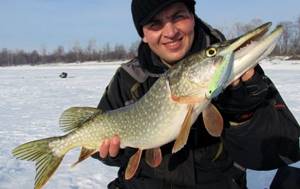
Benefits of rattlin
Any bait has not only advantages, but also disadvantages. Rattlin was no exception. Among the advantages are the following:
- It can be used on any body of water.
- You can fish on rattlin both in the warm season and in winter.
- Even a beginner can master this bait.
- Finding rattlin is not difficult - the bait is sold in almost any store.
The price range for rattlins is quite wide. On the market you can find both cheap Chinese options and premium Japanese models.
Among the disadvantages, it is worth highlighting the main one. Rattlins have poor maneuverability and often cling to snags and algae. However, with the right place for fishing, this drawback will not be relevant. And the advantages guarantee good fishing and catch.
Features of seasonal fishing
Each season of fishing for pike with rattlins will require the implementation of basic rules and recommendations.
Fishing methods in summer
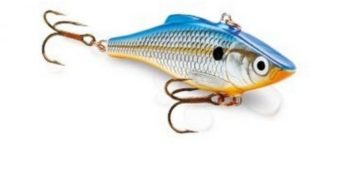
Catching baits for the summer are baits with a body size of 70 mm and a weight of 15 g. Such a rattle will allow you to explore all depth horizons. They start fishing an unfamiliar place from the bottom layer, then, changing the rotation speed of the reel, raise the bait higher.
There are no bites, increasing the rotation speed, they achieve its release into the upper layers. Pike can see the bait from afar and hear the rattle and are drawn from distant areas.
To improve tracking, a counting system is used, when, having determined the count of lowering the bait to the bottom, wiring begins 3-4 counts earlier, in the case of examining the bottom zone. It is better to use bladeless wobblers in areas with a clean bottom or to run them parallel to grass thickets.
In the summer months, pike do not gather in groups, being distributed throughout the entire reservoir. With the help of a rattlin, using the quality of long-range and accurate casting, you can fish large areas without leaving the spot. The noise effect is increased when using braided wire as the main conductor.
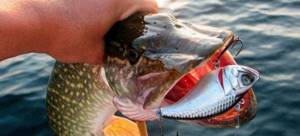
Ice fishing
This is the time for silent models. Size - up to 70 mm. The use of rattlins at depths of 2–3 m can increase the effectiveness of fishing. Heavier and larger ones will help explore depths of over 3 m. The game begins while falling to the bottom.
The glitter style is simple. A jerk is made with the fishing rod to a height of 300–400 mm, a pause. The bait is lowered to a predetermined depth, and the wiring is repeated. There is no bite - in this case, you should not move to another hole, try changing the depth.
The game is more attractive than the behavior of balancers in the water. After a jerk, the rattlin rises and returns to the bottom in an arc, making small-frequency oscillations.
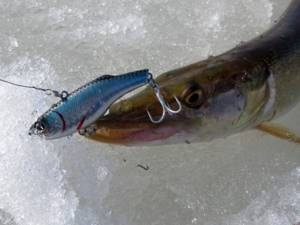
Fishing from a boat
For fishing from a boat, rattlins are used in summer and early autumn. Large bodies of water, bays and areas with overgrown bottoms are the best places to fish with such baits. For effective fishing, you need to perform a slow or medium retrieve, making small jerks with the whip.

Spinning: length 2.4–2.7 m, test 15–18 g. For the main line, braid is used, the thickness depends on the size of the trophies and the transparency of the water. By changing the place where the rattlin is attached, you can change the angle of inclination of the bait.
It is better to hook it on a metal leash closer to the head. If an area with snags or large vegetation is being fished, use stepped retrieval, but do not allow the bait to sink into the thickets.
Experienced fishermen use the method of reconnaissance of the area in a circle or fish the area, dividing it into sectors. The optimal solution when fishing in an unfamiliar body of water and without an echo sounder. But it is important not to forget to fish all depth horizons, especially in the summer, when predators hunt fish escaping in the upper layers.
If after the first trophy a new attack follows, it means that a group of predators has approached this place, attracted by the game and noise of the rattlins. In this case, the boat is anchored and the area is actively surveyed. No bites - change the bait, continue searching for the predator.
In conclusion, some advice from experienced “pikers”.
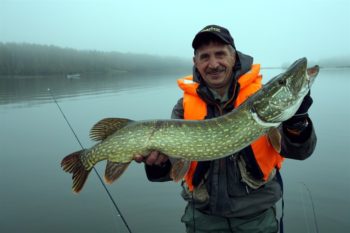
Pike does not like warm water, in which case it is inactive. Go fishing early in the morning or evening. If you manage to get to the river during the day, first of all examine the shaded areas with snags or aquatic vegetation.
In winter, fish are active from 9 o'clock. It is important to carry out the bait correctly when fishing for pike with rattlins. This is a deep-sea bait, so it is important not to lower it to the bottom and snags, but also to lead it directly above the thickets. Therefore, it is important for beginners to learn the methods of stepped and uniform wiring.
Prepare several different colors and sizes of rattlins for fishing, so the catch will be guaranteed.
Happy fishing and outdoor activities.
How to catch pike with ratlins
Rattlins, also known as vibs (from the English “vibration”), are bladeless wobblers characterized by good catchability against river predators. A feature of their design is negative buoyancy, the presence of a built-in rattle and two attachment points for tee hooks. All this increases the likelihood of attracting the attention of the fish and increases the chance of a successful hook.
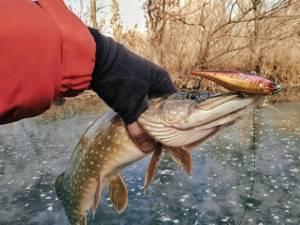
The most aggressive predator of our reservoirs, pike, also bites excellently. But before you go ice fishing, you should figure out which bait models are best to take with you and master the correct technique for placing them. Successful fishing is directly influenced by the following factors:
- The time of year, and for the winter period - its phase. For example, on the first ice, pike can still be very active, aggressively attacking bait near the shore. By mid-winter, it slides into deeper places and becomes more lethargic. Accordingly, the likelihood of a bite decreases.
- Good choice of fishing spot. Using the correct tactics to search for places where there is the greatest likelihood of encountering a toothed predator under the ice.
- Correct rod rig. Well-chosen tackle will help the rattlin to fully open up, showing the most natural game.
- Additional external factors. These include time of day, weather conditions, atmospheric pressure, etc.
Pike rig
The equipment for winter fishing for pike when using bladeless wobblers is chosen to be the same as that used with a spoon or balancer. When choosing a fishing rod, special attention should be paid to balancing the parameters: it should not be too rigid, but at the same time sufficiently elastic. In this case, it becomes possible to feel the movement of the vib well, which is necessary to ensure correct plumbing.
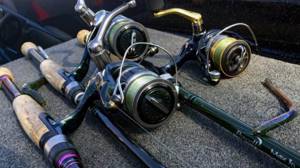
This can be either a spinning rod or a regular fishing rod, about 0.7-1 m long. It is recommended to choose models made of carbon. They have sufficient flexibility and at the same time durable, which is important when fishing for such a large and strong predator as pike. You can choose a regular open type reel, but it is better if it is equipped with a ratchet and a brake. The brake will allow you to fix the bait at a certain depth.
When biting large prey, the ratchet will not allow it to fall off the hooks during jerking: it will provide the necessary slack when the maximum load on the line is reached. However, many experienced fishermen use rods without a reel for ice fishing for rattlins. The fishing line needs to be strong, made of fluorocarbon, 0.25-0.35 mm thick. Otherwise, there is a high chance of leaving the wobbler for the pike as a trophy: the sharp teeth of the predator can easily cut it off from ordinary fishing line.
It is not recommended to use a leash when fishing for viba in winter. The design of bladeless wobblers is calculated to the smallest detail in order to create the most natural game possible when retrieving. To do this, the manufacturer selects a certain shape and weight of the vibration, and the location of the attachment point. The use of a metal leash can adversely affect the behavior of the bait in the water, which will negate all its advantages.
Search tactics
The behavior of pike in winter is somewhat different from the behavior of other predators of our waters, such as pike perch or perch. The general tendency of moving into the wilderness to greater depths, where higher water temperatures remain, can also be seen in pike. However, this is not at all an immutable rule - there are several factors on which the winter mooring location of a predator depends. Pike never gather in schools in winter: larger individuals expel small relatives from their territory or simply devour them.
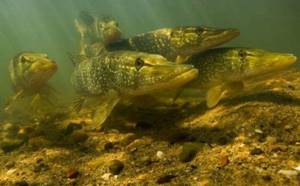
In this regard, one rule applies - if a fisherman has already caught large prey in a certain place in winter, another pike will soon take the vacated place . Large predators can coexist with “pencils” only in summer or autumn, when they live in shallow water and there is enough prey around. In the wilderness, it is impossible to clearly establish at what depth it is most likely to encounter large fish.
Depth for pike is not a decisive factor in choosing a wintering site. Although in the dead of winter it can often be found in pits, quite large specimens can also be found on dumps and edges. During the thaw, it is possible to catch a predator even in shallow water. The main condition is the availability of a convenient place for an ambush. These are large snags, sunken tree trunks, scatterings of underwater rocks. And if such natural shelters are located at a considerable depth, then the chances of meeting a large pike there increase many times over.
Experienced fishermen advise when fishing in winter to look for large predators in the following places:
- thickets of aquatic vegetation (sedge, reeds, bushes) not far from the shore;
- in small lakes and ponds - in holes, on edges, where there are shelters for ambush;
- in the dead of winter, pikes can stand near places rich in oxygen: at the confluence of streams and rivulets into the lake, near underwater springs;
- in fast-flowing rivers, pike can hide in quiet places - behind capes, islands, bends in the riverbed;
- large snags, boulders, and other shelters at depths of up to half a meter;
- edges and slopes.
If you are not well acquainted with the features of the bottom topography, then it would be a good idea to arm yourself with an echo sounder and a chartplotter. Having walked through the intended fishing area with them, you can determine the best places for winter fishing for pike. By drilling holes here and throwing the gear, you can determine how correct your assumptions about the prospects of the intended location were.
Wiring technique
An important point when fishing for pike from ice is the correct technique for placing the rattlin, which ensures the most natural play of the bait. The summer technique of using vibrations is radically different from the winter one. In summer, in open water, the bait is held in a horizontal direction. Accordingly, wobblers are chosen that are lighter and capable of staying longer in the water column. In winter, retrieving from the ice is carried out vertically and consists of a toss, followed by a pause while the bait sinks to the bottom under its own weight.
Despite its apparent simplicity, vertical wiring has many nuances on which the correct performance of the wobbler depends. The secret of catchability lies precisely in these features: in some cases an active toss is required, and in others a slow upward pull is required. In free fall, vibrations also behave individually: some descend quickly, vibrating finely. Others descend slowly through the water column, making complex movements, up to a circular circulation. Therefore, some baits should simply be dropped after pulling, others should be accompanied by a slightly stretched fishing line, and others should be lowered in steps.
In order to better feel the peculiarities of the vibration game and choose the correct wiring technique, it is recommended to practice at home. To do this, you can use a bathtub or other large container filled with water. Don't be afraid to experiment when using rattlins for pike. If one bait option is not suitable or the playing technique does not give the desired result, you should change them. To get the maximum benefit from using vibrations when fishing for pike in winter, a fisherman’s arsenal should have several types of bait and options for placing them underwater.
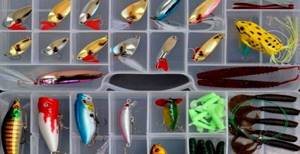
A fisherman should have several types of pike baits in his arsenal.
For winter fishing for pike, two main fishing methods are used:
- uniform;
- stepped.
With the uniform method, after throwing the bait into the hole, we wait until it reaches the lowest point. After this, we begin to smoothly pick up the slack in the line using a reel. The speed of rise and behavior of the vibration depends entirely on the speed of its rotation. When rising quickly, the wobbler begins to actively vibrate, attracting the attention of a predator at a great distance. This can have a good effect in murky water with limited visibility.
To examine the bottom layers of a reservoir, you need to lower the rattlin slowly so that it lingers longer at the lowest point. By choosing the average rotation speed of the coil, you can ensure that the vibration lingers longer in the middle layers. The uniform method is well suited when scouting possible winter sites for pike. By alternating fast and slow retrieves, you can provoke even a sluggish predator in the middle of nowhere to bite.
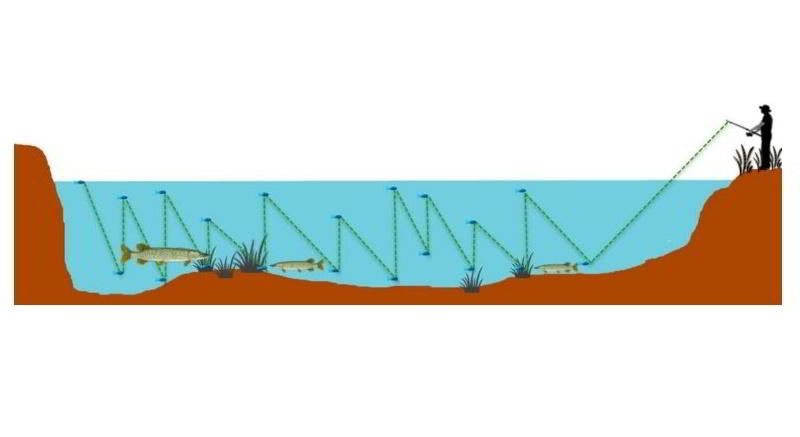
The stepwise method of retrieving is as follows: after casting the bait, you need to wait until it goes down closer to the bottom. Then the coil is rotated several times, after which a pause of several seconds is taken. Afterwards the whole procedure is repeated - 4-5 revolutions and another pause. After reaching the top point of the wiring, the rattlin is again reset to depth and repeating the stepwise wiring again. This method works well when examining edges in lake holes and depressions in river beds.
Rattlins for surface fishing
These models have already proven themselves to be real “killers”. So I’ll list them right away:
- ZipBaits Rigge Vib 63;
- Megabass Vibration Power Bomb;
- Megabass Vibration-X Micro.
A few seconds to deepen - and then just uniform slow wiring. Several attacks per 3-4 m of wiring are guaranteed. Cast in a fan and preferably close, since the flock is already gathered near the watercraft. Here everyone already chooses their fishing credo: either catch more, or send them to grow up.
Controlling vibrations does not require any special sophistication or strictly specialized rods. The only thing that is contraindicated is the soft tip. If you take one rod to a pond, then it should be close to the twitch type. The last time I took St. as my partner. Croix Legend Tournament LTES76MHF. And he was right: both the wind loads and the wave absolutely did not interfere with either the bottom “feel” at great depths or the “elevator mode” in short distances.
Observations of the fishing process
Naturally, they graze harshly on large bodies of water. And although we never left early (we usually started at noon or an hour later), as we fished, the number of boats around us constantly increased. The local “aboriginals” (who were fishing next to us with “sekushi” - winter lures) could not gather the flock and stir it up: their fishing sector, unlike us, was too small. Spinners fishing with jigs were also not particularly happy at a decent wave and 8-meter depth. During my sports activities, I learned to calculate the rate of catching my opponents. The balance was clearly in our favor. At least 1:10 compared to the locals (although there were three of them in the boat and they were constantly moving around the reservoir), and the spinners seemed to be simply swinging on the waves. I noticed fish hatching with them only twice. This is simple arithmetic, when narrow-sector fishing is of low yield, and bottom jig fishing is irrational.
Thus, the entire process of raising and capturing could only be carried out by one fighter. I will repeat its correct name, accepted throughout the world - vib . I am not saying that vibes are only applicable in such deep conditions. I won’t be a hypocrite; in my many years of practice, I have devoted undeservedly little time to this multifunctional and interesting bait. And I only have 15 vibes. Now I’m catching up. Unfortunately, I was not able to catch pike perch this year using vibes. But for pike there will definitely be a continuation.
Rattlin classification
There are several parameters by which rattlins differ. Any bait can work great if the angler has made the right choice taking into account the conditions of the reservoir.
- Wobblers of this type differ in body shape. Lures from manufacturers such as Berkley or Damiki have a wide front surface. They are called "lobed" rattlins. They work great on pike and zander, showing good results in different situations. Even at a low reeling speed, the “lobed” models demonstrate high-frequency play with a small amplitude of oscillations. Lures with a rounded head have a smaller amplitude. Such a wobbler will play only at a certain “overclocking”. The rounded front surface is found in models from well-known companies Yo-zuri, Aise, Masu Masters.
- Rattlins also differ in the presence or absence of rattles inside the body. Some anglers are afraid to use lures that make loud noises, but they do not scare predatory fish. But in muddy water, noisy wobblers attract pike or perch from a great distance. Silent models are preferable to use in cold, clean water, especially in late autumn and winter.
- Most rattlins produced are of medium-sinking design. However, there are extremes, one of which would be heavy models. Such baits are made by Asian manufacturers with an eye on sea fishing. If we compare a Japanese wobbler of the same size with a Finnish one, then the Asian model will weigh 1.5 times more. But such baits work well in deep freshwater bodies of water or in large rivers with strong currents. Wobblers with neutral buoyancy are best suited for catching passive predators.
What rattlins are used when fishing for pike?
It has been experimentally established that rattlins, which create certain turbulences during a dive, are better suited for pike. Many pike lures have a fly or fringe on the back treble. They attract pike very well and provoke them to attack.
Many models have small slots on the sides that give the bait special movements. Such rattlins are suitable for uniform wiring at an average speed. When fishing for active pike, rattlins with balls inside are often used. They create noise, and the pike eagerly attacks these baits.
Pike can be successfully caught using rattlins in winter. For such fishing, models with an elongated body and a silver color are often used. They are good imitators of wounded fish in the bottom layer. Most often they use baits 8-10 cm long with two tees and an oblong body.
